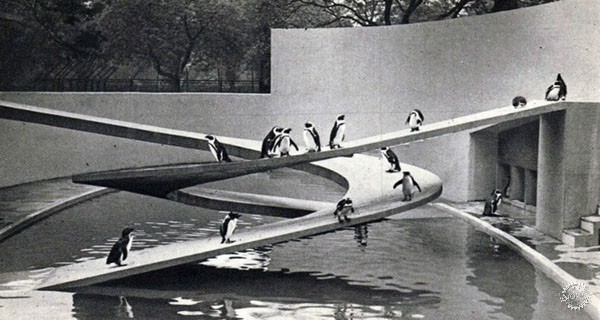
为动物而设的建筑
Architecture for Animals
由专筑网缕夕,杨帆编译
建筑环境的核心是基于人体工程学和人体规模研究,目的是为人类创造一个安全、舒适和启发的栖息地。但是,当焦点转向动物,自然栖息地和社交互动时,会发生什么?当建筑师和景观设计师对建立动物的栖息建筑感兴趣时,它似乎终将归结到动物园——这个将动物展示给公众却将其圈禁在内的设施。
The core of the built environment is based on ergonomics and the study of the human scale, with the purpose of creating a safe, comfortable and inspiring habitat for mankind. But what happens when the focus shifts towards animals, their natural habitat and their social interactions? When architects and landscape designers became interested in creating architecture for animals is not definite. However, it seems that it all boils down to the zoological park, or “zoo” – a facility where animals are displayed for the public and are bred in captivity.
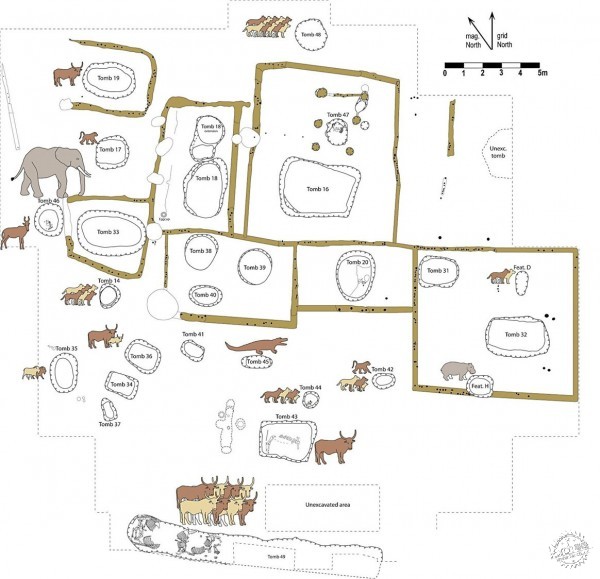
世界上第一个动物收藏品——公元前3500年,在埃及的Hierakonpolis。野生动物骨头被单独发现/The first animal collection in the world – ca 3500 BC, in Hierakonpolis, Egypt. Wild animal bones were discovered buried individually – Image courtesy Renée Friedman
令人惊讶的是,有证据表明,现代动物园的起源与古代有关。在2009年,位于埃及的Hierakonopolis发现了可能是最古老的皇家动物园,这可追溯到公元前3500年。在美索不达米亚,公元前11世纪就有动物和植物园的记录。亚历山大大帝捕获异国情调的动物,并将它们送到希腊,在公元4世纪的主要城市均设有动物园。同样地,罗马帝国圈养这些动物进行学习或娱乐。直到公元16世纪,1520年,这个西太平洋最早的动物收藏名单由阿兹特克皇帝蒙特祖马二世保留,最后却被西班牙的征服者赫尔南•科尔特斯(Hernan Cortes)摧毁。
Surprisingly, there is evidence that the origins of the modern day zoo are linked to ancient times. In 2009, what appears to be the oldest royal menagerie was found in Hierakonopolis, Egypt, dating back to 3500 BC. while in Mesopotamia, there are records of zoological and botanical gardens, from the 11th century BC. Alexander the Great is known to had captured exotic animals and had them sent to Greece, which had zoos in major cities by the 4th century AD. Similarly, the Roman Empire is known to have kept such animals for study or entertainment. The list goes on with various examples around the world, up to the 16th century AD, when, in 1520, one of the earliest animal collections of the Western Hemisphere, maintained by Aztec emperor Montezuma II, was destroyed by conquistador Hernan Cortes during the Spanish conquest.
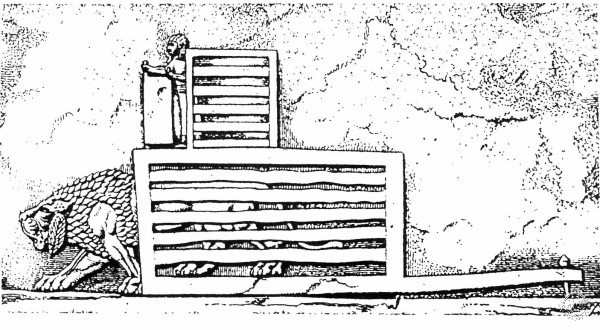
公元前2300年用于运输的亚述狮笼/Image of an Assyrian lion cage for transport, ca 2300 BC
在欧洲,皇家动物园一直至启蒙时代都存在着。其中最著名的是巴洛克式宫殿,如奥地利的美泉宫或法国的凡尔赛宫。由于欧洲共同体的利益转向政府和理性,科学家们扩大了对动物生态学的兴趣。因此,在不同环境中研究异域动物的需要会随着自然栖息地的变化而变化。
Royal menageries continued to exist in Europe, up until the Age of Enlightenment. Some of the most notable ones are associated with Baroque palaces, such as Schönbrunn, Austria, or Versailles, France. As the interest of the European community turns towards government and reason, scientists expand their interest to zoology. Thus, the role and design of the menageries change with the need to study exotic animals in a different environment – one that is more similar to their natural habitat.

Ménageriedu 植物园的动物艺术家——1902年8月7日杂志“L'Illustration”的图片/Animal artists at Ménagerie du Jardin des Plantes – Image from the magazine “L’Illustration”, 7 August 1902
在1793年,第一个现代化的动物园Ménageriedu建于法国巴黎,至今仍然是一个受欢迎的观光景点。在法国大革命之后,属于国王和王后的动物从王室迁移到这里。另一个著名的历史动物园是伦敦动物园,成立于1826年,主要用于科学研究,并于1847年向公众开放。它位于摄政公园,由建筑师约翰•纳什(John Nash)设计。1853年,伦敦动物园开设了第一座公共水族馆,从而扩大了对海洋野生动物的收藏。
In 1793, “Ménagerie du Jardin des Plantes”, the first modern zoological park, was built in Paris, France, where it continues to be a popular destination to this day. Following the French Revolution, animals belonging to the king and queen were relocated here from the royal menageries. Another notable historical zoo is the London Zoo, founded in 1826 for scientific purposes and opened to the public in 1847. It was located in Regents’ Park, during ongoing developments realized by architect John Nash. In 1853 the London Zoo also opened the first public aquarium, thus expanding the collection to marine wildlife.
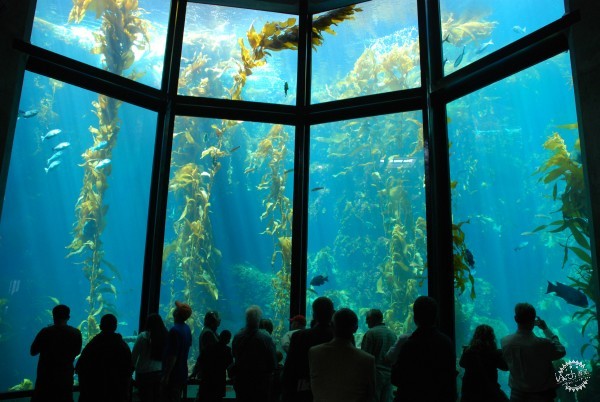
蒙特里湾水族馆,位于加利福尼亚州蒙特利的罐头工厂街。著名的水族馆于1984年开放,包含两个大型水池馆。 其中一个包含了120万加仑的水以及全球最大的单层玻璃窗。/Monterey Bay Aquarium, Cannery Row in Monterey, California. The famous aquarium, opened in 1984, contains two massive tanks. One of those tanks on its own contains 1.2 million gallons of water as well as one of the largest single-paned windows on earth.
动物园仍然遍及整个欧洲,其中最早的包括都柏林(爱尔兰)、汉堡、柏林、斯图加特(德国)或布达佩斯(匈牙利)。与现代封闭式不同,早期阶段的存在性很小。 动物被安置在狭小的空间里,向公众展示。 更令人不安和痛苦的是,早期的动物园甚至设置人体围栏。1906年,纽约的布朗克斯动物园,将侏儒人与黑猩猩一起展示, 展览的参观人数很少,并引发了宗教抗议活动。
Zoological parks continue to appear throughout Europe – some of the earliest ones include Dublin (Ireland), Hamburg, Berlin, Stuttgart (Germany) or Budapest (Hungary). Unlike contemporary enclosures, the ones existent in earlier stages were minimal. Animals were kept in small spaces, where they were displayed to the public. An even more uncomfortable, painful fact is that earlier zoos even had human enclosures. In 1906, the Bronx Zoo in New York, displayed Ota Benga, a pygmy man, alongside chimpanzees and orangutans, as a “missing link”. The exhibition had few visitors and triggered religious protests.
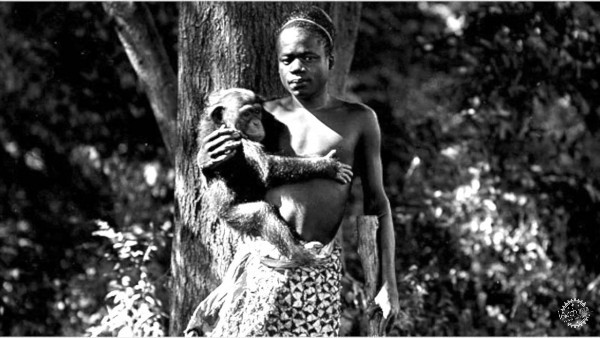
Ota Benga,1906年在纽约布朗克斯动物园与动物一起展出的侏儒男子/Ota Benga, a pygmy man displayed at Bronx Zoo, New York, 1906
20世纪70年代,由于物种灭绝和栖息地的破坏,生态学成为主要焦点。美国动物园协会宣布保护动物成为优先事项,同时终止了动物表演。动物园失去人气,需要重新品牌化的塑造,很快转为保护公园或“生物公园”——这个术语由八十年代后期由华盛顿特区国家动物园首先使用和发展而来。 随着自然栖息地的减少和土地的广泛开发,更不用说为了娱乐而偷猎濒危物种,这些当代生物园的作用至关重要。尽管采取措施,如政府检查或增加动物空间,仍有一些问题需要解决。
During the 1970’s, ecology became a major focal point, as a result of extinctions and habitat destruction. The American Zoo Association declared conservation its highest priority, while also making a stop to animal shows. This was part of a re-branding process, as zoos lost popularity. Zoological parks soon became conservation parks or “bio-parks” – a term first used and developed by the National Zoo in Washington DC, in the late 1980s. With decreasing natural habitats and extensive exploitation, not to mention poaching of endangered species for entertainment purposes, the role of such contemporary bio-parks is undeniably important. Still, there still are problems to be solved, even though measures are taken, such as governmental inspections or increasing the space for animals.

费城动物园的树梢小径为小型灵长类动物提供不同的体验/Treetop trails in Philadelphia Zoo offer a different experience for small primates – Image Courtesy of CLR Design / Arbuckle Industries
当代动物园设计的主要改进之一是基于对动物自然栖息地的研究 - 除景观和建筑知识外,设计师还必须掌握动物学和植物学知识。另一个积极的方面是展展示人与动物的和谐关系。当代动物园设计的最佳例子之一就是费城动物园的总体规划。与典型的围栏不同,游客和动物之间有着精确的限制,费城动物园总体规划提出了连接不同栖息地和地区的小径网络。该策略是基于“动物活动”和“灵活栖息地”的研究。在亚特兰大、路易斯维尔、肯塔基州或克利夫兰的动物园也实施了类似的设计。不过,FASLA的设计师Jon Coe提到,费城是第一个大规模实施这一设计策略的城市,走出了“关键性的一步”。
One of the major improvements in contemporary zoo design is based on the study of animals’ natural habitats – apart from landscape and architecture knowledge, designers must also have zoological and botanical knowledge. Another positive aspect is the improvement of the exhibition display and the relation between animals and viewers. One of the best examples for contemporary zoo design is the Philadelphia Zoo master plan. Unlike typical enclosures, with precise limits between visitors and animals, the Philadelphia Zoo master plan proposes a network of trails connecting different habitats and areas. The strategy is based on “animal rotation” and “flex habitat”. Similar features have been implemented in zoos in Atlanta, Louisville, Kentucky, or Cleveland. However, Philadelphia’s is the first one implementing this design strategy at a large scale, making a “very big step”, as designer Jon Coe of FASLA mentioned.
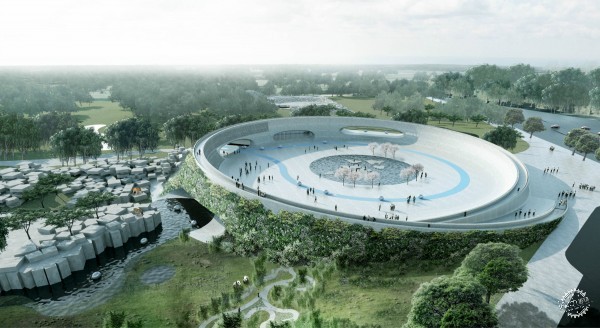
BIG的Givskud动物园的“Zootopia”项目将人类置于笼中/BIG’s “Zootopia” Project for Givskud Zoo will put humans in captivity – Image Courtesy of BIG
设计动物的栖息地一直让建筑师着迷。例如,Cedric Price设计的鸟舍,诺曼•福斯特设计的大象房,还有BIG最近设计的没有笼子的动物园,将古典动物园的形制打破,构建人和动物的新型相处关系。为什么这些杰出的设计师都为动物设计建筑?而且,还有一个问题:这些建筑是否能有效地运行?动物又如何“欣赏”他们的设计?
Designing for animals has always seemed to fascinate architects. Take, for instance, Cedric Price, with his bird aviary, Norman Foster’s elephant house, or, recently, BIG’s cage free zoo that will turn the tables on classical human-animal zoo relations. Why are these illustrious names creating architecture for animals? And, again, there is the question: Is it working? How do animals “appreciate” the design?
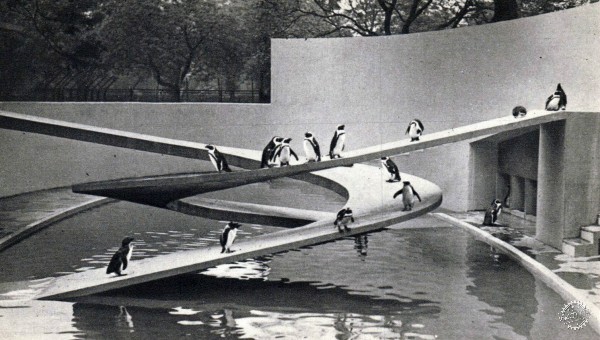
伦敦动物园企鹅池,1934年,设计:Berthold Lubetkin,Lindsay Drake,Tecton/Penguin Pool, London Zoo, 1934, Design: Berthold Lubetkin, Lindsay Drake, Tecton
虽然评论最近的项目还为时过早,但早期的项目可以给予一些反馈。例如,伦敦动物园的标志性企鹅池,由Berthold Lubetkin和Ove Arup设计,似乎并不满足其“居民”的需求。显然,由于混凝土地板,企鹅遭受了痛苦的生活。伦敦动物园的基督西斯提到,“游泳池太浅了,不能潜水和游泳”。他补充说:“这里的黑脚企鹅已经无法挖洞,这是他们求爱仪式的一部分。” 其他动物之家也出现了类似的问题,例如休•卡森设计的野蛮大象和犀牛之家,也在伦敦动物园。尽管这些项目的功能受到了质疑,但这些项目仍然是显著的建筑示例。
Although it is too soon to tell for recent projects, feedback is already available for earlier ones. For instance, the iconic Penguin Pool at the London Zoo, designed by Berthold Lubetkin and Ove Arup, did not seem to satisfy its inhabitants. Apparently, penguins suffered aching joints because of the concrete floor. “The pool is too shallow for them to dive and swim in”, Christ West, of London Zoo, mentioned. “The black-footed penguins housed here have been unable to burrow which is a part of their courting ritual”, he adds. Similar problems appeared in other enclosures, such as Hugh Casson’s brutalist Elephant and Rhino House, also at London Zoo. Although their functionality might be questionable, these projects remain remarkable examples of architecture.

哥本哈根动物园的大象屋/Elephant House at Copenhagen Zoo – Courtesy of Foster and Partners
动物园在历史上发生了很大的变化。 由于紧迫的气候或社会问题,作为保护园区的动物园似乎是一个重要的选择,特别是对保护濒危物种而言。随着动物学和动物行为的不断研究,设计策略仍在不断地发展之中。 虽然已经取得了很大的进步,但还有更多的工作尚未做到。至少我们游客能做到的是,发现并学习动物身上的优点。
The zoological park has changed considerably over history. With pressing climate or social problems, the zoo as a conservation park seems to be a vital alternative, especially for endangered species. Design strategies are still evolving and continue do to so, along with ongoing research in zoology and animal behavior. Great improvements have been made and many more are yet to come. The least we, as mere visitors, could do is fulfill one of their purposes – learn from animals.
出处:本文译自www.arch2o.com/,转载请注明出处。
|
|
